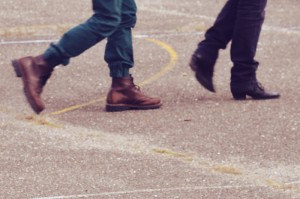Deviation
Titre / Title : Deviation
Participants : Alexandra, Ikhyeon, Quaymberley Dudley
Lieu / Place : Gallia
Date(s) : 1 October 2013
Durée (processus jusqu’à présentation ou à préciser / Duration (process until presentation or to be specified) : One afternoon
Description (medium, genre, concept, questions, critics…) : Experiment
We felt that usually we could move freely anywhere we want to in a public space. This experience has shown us the opposite. From a bird’s eye view, the city looks like a grid we can hardly enter. The map guides us so well that it actually seems to decide where we are going.
We were given a word to write on the map of Strasbourg’s inner city to use as a route that would lead us through the city. Our word from the other group was ‘dévient’ in French. It was a divine word that was extracted from the Bible. We believed it meant go a different route or a different way. From this we decided to stick very close to the path that the word creates on the map. We wanted to be much more strict but it was impossible and frustrating. Our final path was rigid and this is because of the buildings and other structures that blocked our way such as private properties, walls, locked doors, or signboards. To us, human handwriting and the body, is a curvacious and natural shape, unlike the unyielding structure of the city. We related it to the river, which was very soft and smooth and rounded. The way we walk is similar, not as rigid. We made compromises, but the streets remained desperately straight. It was not curved enough to realize a direct walk of our word deviant. The irony to us is that the street, which was built for us, is now disturbing us. After the walk we found synonyms for déviation which are ‘curvature’, ‘deflection’, ‘diversion’ and ‘drift’.
Why did humans build the city in this way? We can easily imagine that streets and roads, are the result of the accumulation of time. We drew an image of desire lines on a page of an empty space and perhaps people followed a path to get from one point to the next. Every time they walked they made a new path or a deeper cut into the old one. Eventually an idea of a road developed. Then they built the road in the path and this is what made it straight. We could say that the urban grid is the result of a compromise of all those paths.

